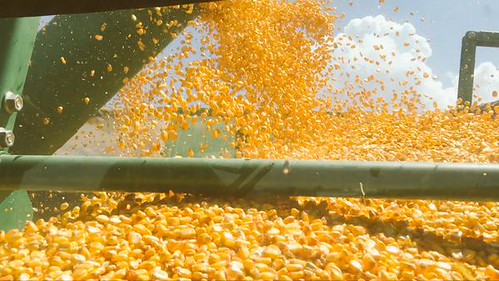Commodity futures prices drop sharply in wake of new USDA production estimates
By Ryan McGeeney
U of A System Division of Agriculture
Aug. 18, 2017
Fast Facts:
- Aug. 10 report showed rise in all Arkansas yield forecasts
- Arkansas cotton, hay and soybean production up; corn, rice and sorghum down
- Arkansas corn harvest slowed by rain
(591 words)
(Download this story in MS Word here.)
LITTLE ROCK – Prices for most commodities have taken a beating in the week since the U.S. Department of Agriculture released its Aug. 10 Arkansas Crop Production report.
Projected yields for Arkansas corn, cotton, rice, sorghum, soybeans and winter wheat all rose to some degree over 2016 yields. Overall production forecasts for cotton, hay and soybeans in the state also rose over 2016 numbers, while expected production for corn, rice and sorghum fell.
Scott Stiles, economist for the University of Arkansas System Division of Agriculture, said that the August production report is the first of the season to incorporate field surveys into forecasts. Because the USDA’s National Agricultural Statistics Service’s condition rating of the U.S. corn and soybean crops had been trending lower in weekly crop reports throughout July, commodity futures markets reacted sharply to the Aug. 10 report, which was considerably more optimistic about yields, he said.
Nationally, the projected 2017 soybean yield estimates actually fell from 52.1 bushels per acre in 2016 to 49.4, while Arkansas yield estimates rose from 47 to 49 bushels. However, national soybean production estimates rose by almost 75 million bushels to a record 4.38 billion bushels, triggering a price reaction of 33 cents, falling from about $9.73 a bushel to $9.40.
“November soybean futures have lost as much as 52 cents following the Aug. 10 USDA report,” Stiles said.
Corn futures contracts fell 23 cents a bushel since the Aug. 10 report. Cotton futures fell from about 71 cents a pound to less than 67 cents. Wheat futures fell from about $5.30 a bushel to about $4.94.
“The bottom line is that the report was really negative for crop prices overall,” Stiles said. “The day of that report, you saw corn, wheat, soybean, cotton prices — everything, really — turn lower. It’s had a huge impact on the price outlook for our growers.”
The state’s one major commodity that seems to have been spared is rice. With national production down from about 224.1 million cwt in 2016 to an estimated 186.5 million cwt in 2017, primarily due to spring flood damage in Arkansas and surrounding states, Chicago Board of Trade rough rice futures contracts have consistently trended upwards since May, Stiles said, to more than $12 per hundredweight.
Meanwhile, production and harvest in Arkansas remains afoot. Jason Kelley, extension wheat and feed grains agronomist for the Division of Agriculture said growers are hoping for sunshine and a cessation of rain long enough to harvest the majority of corn throughout the state.
“Some of the earliest harvesting began three weeks ago,” Kelley said. “The longer it sits out there, the more our potential for lodging goes up. Anytime it lodges, we’re just never able to get all of it into the combine.”
Both cotton and soybeans are likely to benefit for continued moderate August temperatures. Bill Robertson, cotton agronomist for the Division of Agriculture, said the summer rains, while problematic for some aspects of the state’s agricultural industry, have helped cotton growers reduce input costs.
“Mother nature has helped us a good deal with rainfall,” Robertson said. “We’ve had to put a little less money into our crop in terms of irrigation costs. One thing in the back of everyone’s mind is target spot, but the crop is far enough along that it’s not going to cause an economic problem. It’s not over yet, but we are close enough to the end that everyone is ready to stop spending money on the crop.”
To learn about Arkansas row crops, contact your local Cooperative Extension Service agent or visit www.uaex.uada.edu.
About the Division of Agriculture
The University of Arkansas System Division of Agriculture’s mission is to strengthen agriculture, communities, and families by connecting trusted research to the adoption of best practices. Through the Agricultural Experiment Station and the Cooperative Extension Service, the Division of Agriculture conducts research and extension work within the nation’s historic land grant education system.
Pursuant to 7 CFR § 15.3, the University of Arkansas System Division of Agriculture offers all its Extension and Research programs and services (including employment) without regard to race, color, sex, national origin, religion, age, disability, marital or veteran status, genetic information, sexual preference, pregnancy or any other legally protected status, and is an equal opportunity institution.
# # #
Media Contact: Mary Hightower
Dir. of Communication Services
U of A System Division of Agriculture
Cooperative Extension Service
(501) 671-2126
mhightower@uada.edu
Related Links
